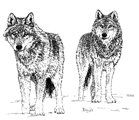Center, Internet, Wildlife Damage Management

Rocky Mountain Wolf Recovery: Annual Reports
Date of this Version
May 2004
Abstract
The U.S. Fish and Wildlife Service (USFWS) is restoring endangered gray wolves to the northern Rocky Mountains including ongoing efforts in 3 restoration areas: Northwest Montana, the Greater Yellowstone Area, and Central Idaho. Gray wolves naturally recolonized northwest Montana and were down-listed to threatened status under the Endangered Species Act (ESA) in 2003. Nonessential experimental population areas were established for the Greater Yellowstone and Central Idaho Areas where wolves were actively reintroduced under the ESA. This special designation allows for management flexibility to address public concerns such as wolf-livestock conflicts. In 2003 the USFWS reclassified gray wolves across the lower 48 states to better reflect the species current population status. The USFWS changed the classification of the gray wolf under the ESA from endangered to threatened in those portions of historic wolf range except for the Mexican gray wolf, Central Idaho, and Greater Yellowstone Experimental Population Areas. Wolves outside of historic range within the continental United States were delisted and no longer afforded protections under the ESA. At the end of 2003, the Central Idaho Experimental Population Area (CIEPA), was home to an estimated 379 wolves including 38 known wolf packs. Thirty-one of those produced litters, 26 of which met the recovery requirement for a breeding pair - an adult male and an adult female wolf that have successfully raised at least 2 pups to December 31 of their birth year. The population recovery goal for the Northern Rocky Mountain Recovery Region (NRMRR) - to maintain 30 breeding pairs of wolves equitably distributed across the 3 restoration areas for 3 years - was achieved at the end of 2002. Wolves were well distributed across 28,473 square miles (73,746 square km) of the Idaho portion of the CIEPA at the end of 2003. Territories of all known packs and pairs were completely or predominately within National Forest lands, 13 of which included federally designated wilderness areas. Eleven new breeding pairs were documented in 2003 and a minimum of 103 wolf pups was produced. Five packs, first documented in 2003, were retroactively counted as 2002 breeding pairs based on pack size and presence of subadult wolves. Estimated minimum average litter size for all packs that reproduced, including those where counts were suspected incomplete, was 3.3 pups per litter for 2003. Documented wolf mortalities during 2003 decreased from the previous year. Of 15 wolf mortalities with known cause, all (100%) were human-related. There were 2 deaths of undetermined causes and 1 suspected mortality. The fates of 9 radio-collared Idaho wolves that dispersed within the NRMRR were documented during 2003. Undoubtedly, additional wolves without radio-collars dispersed as well. Tracking the movements of dispersing wolves between recovery areas lends credence to the notion that the NRMRR is a single, interconnected metapopulation. Capturing and radio-collaring wolves remained a priority. During 2003, 46 individual wolves were captured, which resulted in the deployment of 33 new radio-collars and the re-collaring of eight individuals. Although wolves are captured and collared every year, the proportion of radio-collared individuals in the population decreases with expanding numbers of wolves, increasing the challenge of monitoring the activities, distribution, and status of the wolf population. Confirmed and probable wolf-caused livestock losses during the year amounted to 23 cattle and 144 sheep. In addition, 6 dogs were confirmed killed by wolves, while 1 additional dog was categorized as a probable wolf kill. As a result of agency control actions, 6 wolves were lethally controlled and 6 were radio-collared and released on site through agency control. One wolf was legally shot by a livestock producer. Scientific information collected through peer-reviewed research will foster a better understanding of wolf ecology and the effects of wolves within the ecosystems they inhabit, leading to effective wolf conservation and management. The Idaho Wolf Recovery Program (Recovery Program) continued to initiate and support ongoing research.


Comments
Mack, C. M. and J. Holyan. 2004. Idaho Wolf Recovery Program: Restoration and management of gray wolves in central Idaho. Progress report 2003. Nez Perce Tribe, Department of Wildlife Management, Lapwai, ID. 47 pages.